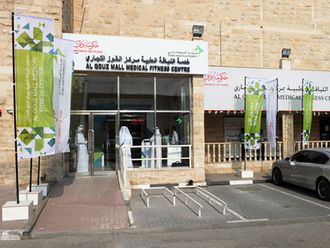At the newly-opened gourmet Lebanese restaurant, Fakhreldine, at Holiday Inn Dubai, desserts are an entirely pleasurable experience. Rich, satisfying and extremely irresistible, they are the result of a tradition that began in the original London restaurant 21 years ago. Fridaypresents a few sweet ideas for the Holy Month of Ramadan
The story begins some time in 1978 when a man named Adib Al Ayache landed in the UK from Lebanon. A civil engineer by qualification, Adib, a connoiseur of fine food, particularly Lebanese cuisine, was more than a little upset to find that there were hardly any restaurants in the UK serving quality Lebanese food.
There were a few options: he could cook whatever he loved at home and satisfy his longings. He could settle for food from any of the 6-7 outlets which were dishing out Lebanese fare. Or he could open a restaurant where discerning food lovers could taste authentic Lebanese dishes. He decided on the last option. The result was Fakhreldine.
Today, the restaurant standing opposite Ritz London, is a landmark for traditional Lebanese cuisine and hospitality and is "the best Lebanese restaurant in Europe," according to the Observer Magazine.
"For me, Fakhreldine is more than a restaurant," says Adib. "It is a part of my Lebanese culture that I managed to carry to Europe.
"Some time ago, a friend of mine from Dubai came to my restaurant in the UK and, in the course of our conversation, asked me why I had not considered setting up an outlet in Dubai." That set Adib thinking. Dubai, he knew, was fast becoming a popular tourist and business destination.
Also, there were not many food outlets offering authentic Lebanese cuisine. He decided to rectify this. Thus in September, the gourmet restaurant serving Lebanese cuisine opened in Holiday Inn Bur Dubai.
Named after Prince Fakhreldine II, one of the most prominent figures in Lebanese history who was known for his hospitality, Fakhreldine's Dubai edition is a continuation of the original Fakhreldine concept in London but with more features.
"Our stress is on presenting food with the home-cooked taste," says Adib. "We also lay great emphasis on quality and hygiene."
So refined are his taste buds that, "When I taste something, I can immediately assess the quality of the ingredients in a dish. I have acquired this through sheer experience. I travel a lot and when I am in a different country, I go to the best hotels of that place. That way, I get to taste the best food."
Adib puts his experience to good use in the kitchens of his own restaurant. "I insist on my chefs using only the freshest ingredients and maintaining exact measurements. I don't believe in simply tossing in things to create taste. Everything has to be in exact proportions."
Lebanese cuisine is known for more than just its salads and dips. It also has a wonderful repetoire of sweets. "Oh yes," says Chef Haisan El Ayache. "Lebanese cuisine has a wide variety of sweets. And they are quite popular too. In fact, Fakhreldine London has a special kitchen dedicated to making Lebanese sweets. "We use pure ghee for preparing the sweets," says Adib.
"This is the ghee made from pure cow's milk and sheep's milk and has a distinctive flavour." And which are the sweets which Fakhreldine is known for? "Macaroon, Osmaliya, Namoura, Zounoud El Sit... oh! there are many," says Adib.
In fact, many of the desserts at Fakhreldine are particularly unique in the way they incorporate a little 'extra' flavour. Some of the desserts are not to be found in many Lebanese restaurants.
"We use a lot of milk and milk- products in our desserts," says chef Haisan. Though rich in calories, the desserts are delicious. The ones using clotted cream are quite simply, unforgettable. Their taste and texture linger long after the guilt of indulging in them has passed.
Macaroon
Macaroon. © Gulf News |
1 kg semolina
300 gms white flour
500 gms sugar
2 cups yoghurt
1 tsp yeast
1 cup ghee
Sugar syrup, for soaking
Method
Mix all ingredients together except the sugar syrup and knead well. Leave the dough to rest for two hours. Make small balls of the dough, roll each one out and cut into small squares. Roll each square to form a tight cylinder.
Deep fry and let it cool. Pour sugar syrup and allow it to soak the syrup before serving.
Halawa Bi Jibn
Halawa Bi Jibn. © Gulf News |
1 kg white flour
500 gms cheese (majdouleh)
Rose water, to taste
Kevda water, to taste
1/2 cup clotted cream
Method
Mix all ingredients in a processor till a smooth dough forms. Flatten the dough and using a large diameter cookie cutter, cut it into rounds. Fill the centre of the rounds with clotted cream and fold over the sides to form a parcel. Pour sugar syrup over, decorate with pomegranate flowers (available in many Lebanese supermarkets). Allow the syrup to soak in a while before serving.
Zounuod El Sit
Zounuod El Sit. © Gulf News |
1 packet filo pastry
Oil, for frying
Filling
1litre milk
200 gms sugar
300 gms samolina
Mastic gum, to taste
Method
Mix milk and sugar and boil until sugar melts. Add semolina and mastic gum, mix well and take off the fire. Allow it to cool. Cut filo pastry into large squares. Top each square with the filling, make a roll and deep fry rolls till golden. To serve, dip each roll in sugar syrup, place them on a plate, decorate with pomegranate flower.
Osmaliya
Osmaliya. © Gulf News |
500 gms
Shaar
Osmaliya
2 cups vegetable oil
Sugar syrup
Clotted cream
Method
Put the Shaar Osmaliya in a 9"x13" tray and cover with vegetable oil. Place in a preheated 170?C oven and bake till the shaar osmaliya turns golden. Cut into half. Top one half with clotted cream and cover it with the second half. Garnish with clotted cream and pour sugar syrup over it.
Namoura
Namoura. © Gulf News |
500 gms semolina
500 gms sugar
2 cups yoghurt
1 tsp soda bicarbonate
2 tbsp kevda water
2 tbsp rose water
2 tbsp butter
Method
Mix all the ingredients to












